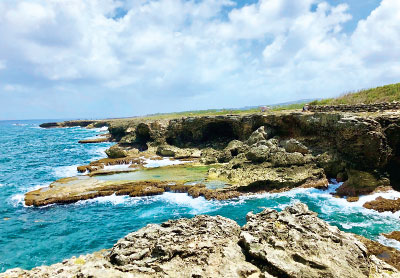When I was a schoolboy, I had to recite a geographic truth constantly. It was that Barbados was shaped like a shoulder of mutton, with its narrow end marking the north of the island. The land at that very tip was called North Point. It was flat and dry and seemingly abandoned. Standing on that ground was like being on a cliff looking way out to sea. On a sunny day, the water was a deep blue maelstrom of interactive currents, contrasting sharply with the white, foamy waves crashing on the rocks below.
Whenever I return home, I make the pilgrimage to North Point. On the way there, in the last mile or so, I go past St. Swithin’s Anglican Church, named after an Anglo-Saxon bishop from the fifth century. The name seems incongruous with an Antillean country village. Still, every time I pass the church, I decide afresh that it marks the entrance to this utterly beautiful area, desolate in a certain way, even deathly quiet at times. The vista of the sea, the salty breeze competing with the imposing warmth from the sun, and the occasional sheep or goat roaming unimpeded and owning the territory create an improbable landscape. I love my connection to this place.
I have had to return to memories like this during the last few months, as the coronavirus has rambunctiously forced me to seek refuge from its rampage. Several friends have told me of their personal experiences with confinement to home. The boundaries of the space seem to close in, making the square footage progressively smaller and turning home into what Professor Chester Pierce used to call an extreme environment. The perceived change limits movement and imposes a new monotony that can be frightening. My friends complain of being cut off from familiar support networks and landscapes. They dislike the isolation and miss the consistency and reliability offered by their pre-pandemic lifestyles. They describe a feeling of stark isolation and an inability to master their small spaces and their energy and mobility. One might say they no longer feel at home in their restructured homes. They have been exiled from outside to the inside. Homes can be cocoons of comfort. The pandemic mocks that claim.
Pierce emphasized two other elements in conceptualizing the extreme environment. The first is amorphous structure. This refers to our need for some orderliness and predictability in our average day, as well as our frustration caused by the contradictory advice about the virus that bombards us daily. The second element, indefinite stays, frames the uncertainty about when the confinement will end, which worsens our anxiety. A feeling of abandonment sometimes takes over, and we become hypervigilant. As I contemplated all this while reminiscing about my dialogues with Chester Pierce described in Race and Excellence (University of Iowa Press, 1998), it struck me that the accounts of present concerns linked to the coronavirus sound like tales of exile. Most prominent is the loss of pleasant remembrances focused on planning for the future.
I try to hold on to my memories of North Point, where I always feel so relaxed and untethered, waiting for ancestral voices to whisper in my ear and grateful for the chance to savor nature’s elegance. I conclude that there are some magnificent places on earth, even on a little island in the Caribbean. At North Point, incidentally, there is now a small restaurant overlooking the water. I enjoy its blackbelly sheep stew with rice and the bread pudding for dessert. Souvenirs of pilgrimages to these distinctive places of safety and freedom can be an antidote to extreme environments.
Frauke Josenhans and colleagues, in Artists in Exile: Expressions of Loss and Hope (Yale University Art Gallery, 2017), discuss the problem of being separated from what is familiar to us. While we become preoccupied in the new space with the imagery of loss and alienation, Josenhans and colleagues explain that restorative nostalgia can help us reimagine home and reinvigorate our resilience. ■


